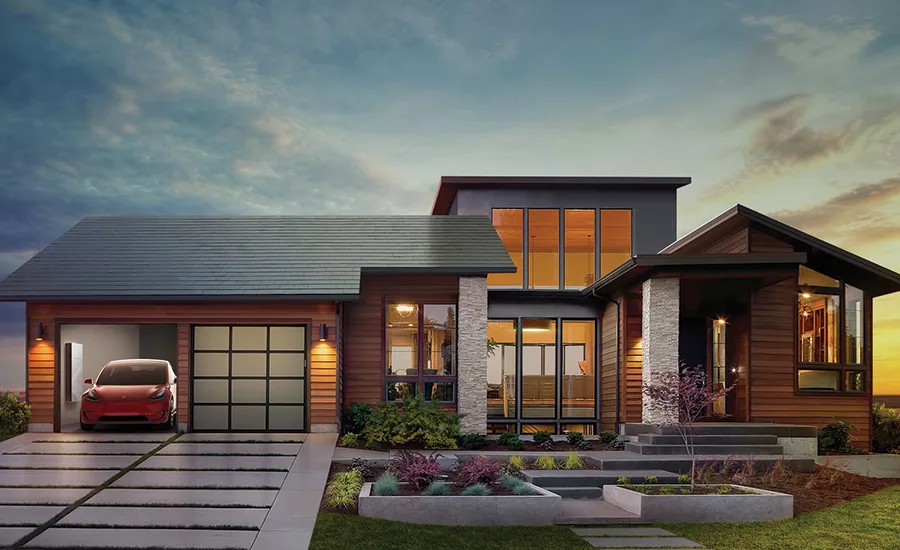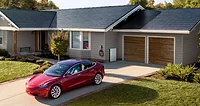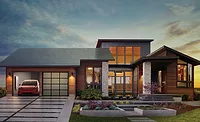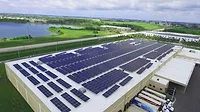Solar Spectacle: Elon Musk’s Solar Shingle Gamble
The plan isn’t resonating with roofing experts, but they’re paying attention.

Tesla CEO Elon Musk turned a lot of heads last fall by unveiling his much-anticipated ‘solar shingle.’ And while many in the roofing industry watched, few believe the spectacle of his announcement will cause a true pivot in how advancements in residential solar technology will reach the masses.
Musk’s solar shingle mimics traditional tile roofing, but encased within the translucent glass tiles are solar cells designed to capture the sun’s rays and convert them into enough energy to power the households they cover. His flamboyant announcement — made live from a Hollywood soundstage designed like a typical neighborhood of upscale homes — coincided with the release of Tesla’s latest version of the PowerWall home battery.
He stated his ambition to create a seamless synergy between solar technology that can power both a typical home and Tesla’s electric vehicles already on the market.
As part of his pitch, Musk talked about climate change and the record carbon dioxide levels currently on Earth as the urgency to make solar roofs look better, generate more electricity, last longer and install more cheaply than a traditional asphalt shingle, tile or slate roof.
“We really need to make solar panels as appealing as electric cars have become,” he said, foreshadowing his vision for an integrated-battery lifestyle.
If his team is successful, “Why would you buy anything else?” Musk asked during the presentation.
Looks can be Deceiving
Industry experts agree that Musk raised a good question, and that his focus on integrating renewable energy sources at the household level is essentially the right vision for the future of solar. However, many found the announcement underwhelming — in that it was focused on selling the public on design and aesthetics rather than revolutionary technology and improved solar efficiency.
“Like many ‘latest and greatest’ technological announcements, Tesla’s Solar Roof leaves us with more questions than answers,” wrote Michael Carnahan, general manager of Scalo Solar Solutions in a column for RC’s December 2016 edition. “Until they release any specifications, we’ll reserve judgement.”
Other industry leaders noted that Musk’s attempt to enter the roofing business via solar technology — though ambitious — has been tried before and met with mixed results.
Late last year, Dow Chemical scrapped production of its Powerhouse solar shingle line after nearly a decade of development and five years of lukewarm sales.
Shingle-producing giant CertainTeed entered the solar market with the Apollo shingle product in 2011. Now in its second iteration (Apollo II), officials say product sales increased faster than the standard in the solar residential market in part due to increased exposure of solar energy’s benefits to homeowners.
But challenges remain — including many that have tested the residential solar market for years. The physical appearance of rack-and-panel solar systems aside, cost is at the top of the list. And that’s even with significant advancements in traditional solar panel production and the availability of silicon — the dominant product of choice for solar cell manufacturers in today’s market.
Efforts by congress to extend the solar tax credit last year for another five-year window should also make a difference. The extension alone helped spur the anticipated annual growth rate for solar producing capacity in the United States by 39 percent for 2017, according to data from the U.S. Dept. of Energy.
Besides cost, other challenges include the ability to capture enough energy to match consumption, and perfecting methods to store and transfer that energy cheaply and efficiently.
“While the products presented certainly look great, there are still many major questions left unanswered surrounding cost, installation and channel to market,” said Chris Fisher,
CertainTeed’s solar product manager. “We applaud the announcement and the intent; CertainTeed’s vision from the beginning was to develop aesthetically pleasing solar roofing products, but we’ve chosen to take a more practical approach with our Apollo II product line in today’s solar market.”
Though he wouldn’t discuss schematics or price, Musk did say the entire roof would cost homeowners less than a new roof installation combined with the cost of electricity over the roof’s life cycle.
A Matter of Time
The timing of and timetable for Musk’s solar-roof ambitions shouldn’t be overlooked, either.
Several roofing industry experts noted that his highly-publicized announcement, which was streamed live to thousands around the globe and viewed more than 2 million times on YouTube — came just weeks before a critical stockholder vote to merge Tesla and SolarCity.
The impact on stock prices and investor optimism was evident. Last November, shareholders of both companies overwhelmingly approved the merger in a deal projected to be worth at least $2 billion.
“We would like to thank our shareholders for their continued support throughout this process,” company officials said in a written statement. “We look forward to joining Tesla to show the world what Tesla and SolarCity can achieve together.”
The solar shingle is the initial cornerstone for that partnership. Without approval, Musk’s solar-roof concept would’ve likely stalled or practically died altogether. Now with the proper funding mechanism and mandate to bring the companies together, plans to make the products market-ready quickly are under way.
Though still light on technical details and specifications, Musk did reveal some intentions during his address to shareholders on the day of the vote.
He said Tesla will unveil the first version of the solar shingle sometime this summer, and that three other “main types” of shingle panels will follow. The initial product will be the most likely in demand by homeowners, and the three others will be released in three-month cycles stretching into 2018.
The cost, he added, will depend on the size of the home and level of installation difficulty, but still should be at least equal to, if not cheaper than the cost of the traditionally-installed residential shingle roof.
The cost savings will be in distribution — namely transportation, which Musk says is currently terribly inefficient in the roofing industry. The glass-composed solar shingle weighs much less than traditional ceramic or concrete tiles and will be easier and cheaper to move around the country.
SolarCity officials declined further comment to Roofing Contractor, but the business appears to have the manufacturing capacity to make the timeline feasible. The company recently completed a $900 million facility in Buffalo slated to begin producing the solar panels later this year.
Ultimately, the product’s success could depend on Musk’s other potentially-groundbreaking endeavors, including reusable space rockets and Mars colonization, industry observers said.
“In many ways, Elon Musk is a modern-day Thomas Edison; and he shares many of the same strengths and shortcomings that Edison displayed over a century ago,” said Jim Hoff, president of TEGNOS Research, Inc. and long-time RC columnist. “He’s ambitious, confident, unbelievably smart and has a sense of vision that allows him to reach for goals few others could even understand let alone attain. That said, Musk, like Edison, has shown a large appetite for moving so many difficult ventures forward.”
Looking for a reprint of this article?
From high-res PDFs to custom plaques, order your copy today!








